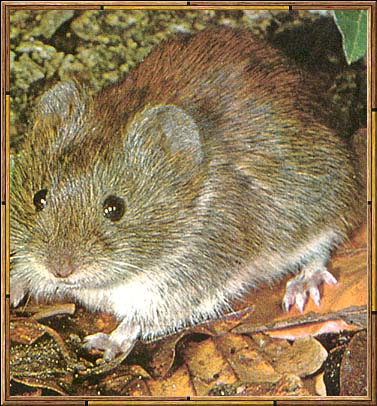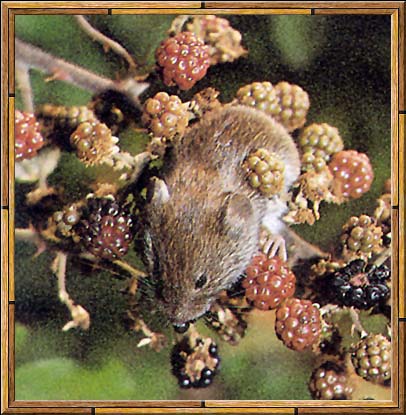
Clethrionomys glareolus
The Bank Vole
Bank voles are widespread across mainland Britain, but are absent from some offshore islands, although some islands have their own sub species, which would still be able to inter-breed with the mainland variety. Bank voles range across Europe (except for the extreme north or south) and east into central Asia. The bank vole is the smallest of the vole species in Britain and after the wood mouse it is probably Britain's most abundant small rodent. They are widely distributed throughout Britain, and were accidentally introduced to the south west of Ireland in the 1950s.
Each Bank Vole occupies a home range, marking it with urine and does not normally venture more than 50 yards (no I am not going to put in the metric equivalent so there) from it's nest. Males generally range more widely then females do making tunnels through the grass so that it can forage unseen during the day.
The nest burrows are set in soft soil, normally between the roots of a large tree or shrub, and has several entrances to the surface. It's habitat is broadleaf woodland, scrubland, hedgerows and sometimes gardens where there is plenty of ground cover and food. It lives mainly on grass, roots, fruit such as apples, seeds, and also insects and earthworms. Mainly diurnal, with a maximum lifespan of 18 months.
This little chap or chapess obviously likes his or hers blackberries
(You've got to be politically correct haven't you..?)Biology:
Head and body length: 8-12cm, Weight: 15-40g
The Bank Vole is easily distinguised from other voles by its rusty coat and longer tail. It also differs in habits from the Common Vole which occurs mainly in fields and eats cereals and the seeds of weeds.
The bank vole reaches sexual maturity at 4 - 5 weeks old, as, like most other rodents, it has a short life expectancy. Some may only live for a few months, although others will live for up to a maximum of 2 years The female vole often produces as many as 4-5 litters in a single year. The breeding season is between April & October starting in the spring and reaches the peak during June.
The female gives birth after a gestation period of 16-18 days, to 3-6 sightless, naked young in the underground nest which is lined with grass, moss, and feathers. The young are weaned off the mother's milk after two or three weeks, gain sight after about 14 days and become independent in about 9 weeks, but over half of those born early in the season will die before they are 4 months old. They will be able to breed in a few months, and the females of the first litter of the season can produce a litter of their own later that same year.
The bank voles main predators are mainly tawny owls, weasels and foxes.
